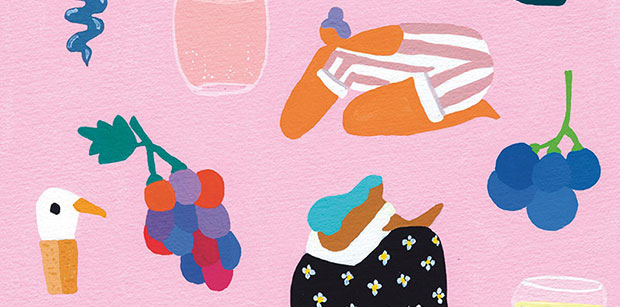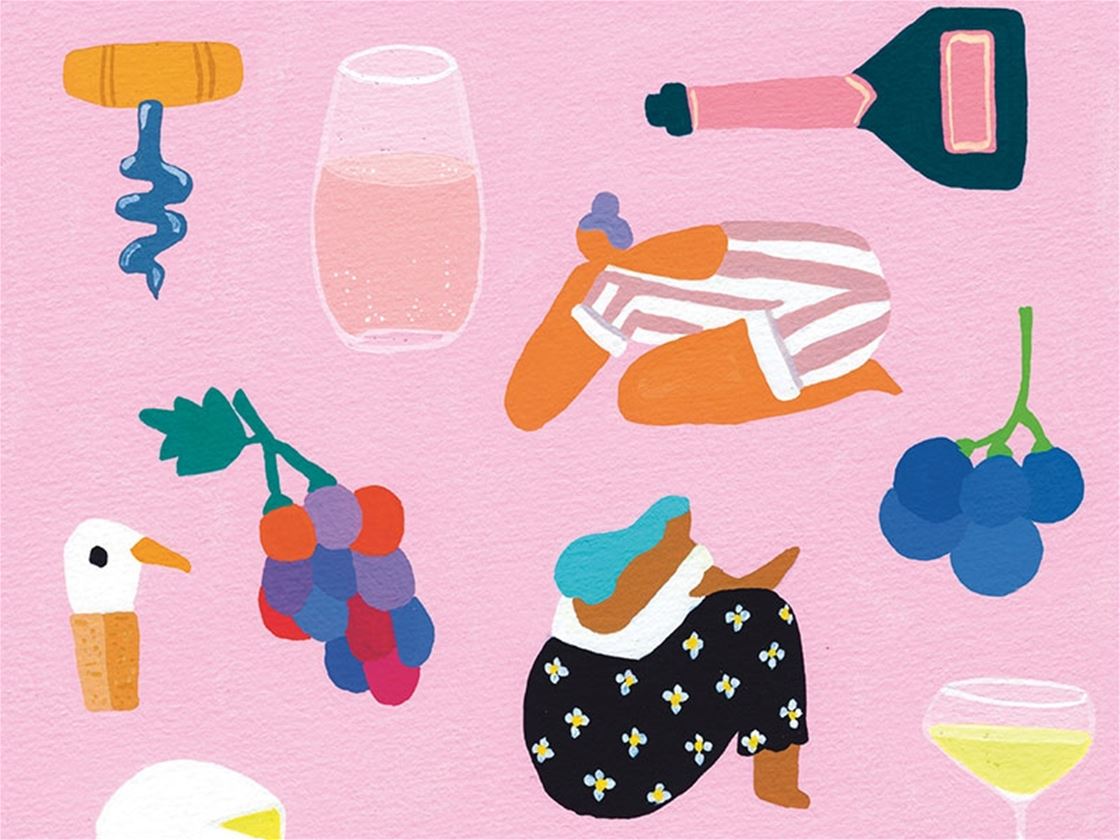a simple guide to becoming a wine snob
If you’d like to know more about choosing a good drop, this article is for you: our ultimate no-fuckwittery guide to wine appreciation.
It’s OK to not know heaps about wine. To never have considered that a glass of vino could be ‘cheeky’, ‘flamboyant’ or ‘chewy’. Don’t let the glass-sniffers and bucket-spitters make you feel inferior! But if you’d like to know more about choosing a good drop, and think ‘terroir’ is a type of small dog, this article is for you: our ultimate no-fuckwittery guide to wine appreciation.

Art by Joanne Ho aka Helo Birdie
WHAT IS WINE, ANYWAY? Let’s start at the beginning. (You’ve got to crawl before you can spit.) Wine is normally made from fermented grapes, although technically, you can make rice wine, plum wine, cherry wine and pomegranate wine, too – any old fruit will do. There are more than 1300 different grape varieties used in commercial wine production, but the most-planted grape in the world is the trusty Cabernet Sauvignon (‘Cab Sav’ to you and me). And no, these aren’t like the grapes you ‘test’ (read: steal) in the fresh produce section of the supermarket. Imagine something halfway between the juicy summer fruit and Sultana Bran: smaller and sweeter, with a thick skin, less crunch and seeds inside.
WHERE DOES THE FLAVOUR COME FROM? Hundreds of years and billions of dollars have gone into answering this question (no joke – the global wine industry is worth over $300 billion). When wine ferments, yeast gobbles up the grapes’ natural sugar, releasing alcohol, carbon dioxide and about 200 different aromas (also known as ‘esters’). Which esters you get, and how delicious and aromatic they turn out to be, comes down to zillions of factors: the quality of the soil, the lineage of your grapes, the strength of the sun, the altitude and air pressure, the colour of your flippin’ shirt. This is what people mean when they talk about ‘terroir’. It’s the mystical alchemy of dirt, light, sugar and time that gives wine its character. Other elements that can affect taste include the barrel the wine was aged in and the amount of ‘tannins’ – naturally occurring compounds that exist in grape seeds, skins and stems, and make a wine seem dry or bitter. (A little like sipping on black tea that’s been brewing for ages.)
WHAT ARE THE DIFFERENT VARIETIES OF WINE? There are five main types of wine: red (made from black grapes), white (made from white grapes), rosé (made from skinless black grapes or a blend of white and black), sparkling (fermented twice for extra bubbles) and dessert (the sort of wine they drink in Frasier). Beyond that, it gets messy. There are brick-sized tomes that classify every varietal and sub-varietal known to science, but you probably don’t have to worry about the subtle fruity differences between Lambrusco ‘Spumante’ and Lambrusco ‘Dolce’. Life’s too short, honestly. Memorise these familiar faces instead – they should cover 90 per cent of dinner parties.
Chardonnay: A pretty daggy white wine, full of nutty, oaky bits. Super-popular in the 1980s.
Sauvignon Blanc: Australia’s biggest-selling white wine. Think light and zesty, and packed with fruit.
Riesling: A classic white-wine chameleon. Can be ‘dry’ (lacking sweetness) or sweet, crisp or zingy. Ask for a taste-test before committing to a bottle.
Pinot Grigio: A delicate, ‘light-bodied’ white wine that’s hella trendy these days. It’s usually crisp and quite quaffable.
Pinot Noir: The red wine for people who hate red wine. Subtle, fruity and fun to order.
Cabernet Sauvignon: Lots of body, lots of tannins. Plenty of va-va-voom. That’s your Cab Sav – a bold, ‘full-bodied’ red.
Shiraz: Buckle up. Shiraz is like a peppery blackberry exploded in your mouth. Bold and ballsy.

HOW DO YOU TASTE WINE? We should really add ‘…without looking like a knob’. Because we all know how to taste wine, right? You get the sommelier (or helpless wine waiter) to pour a little into your glass, then swish it around, sniff with your eyes closed, slurp the smallest possible amount and – whoosh! – you’re suddenly in a little village in Piedmont, Italy, watching an old lady stomp grapes with her feet. It’s all very dramatic.
You don’t have to drink wine like that, but if you really want to suck up every flavour atom, here’s how it’s done. Step 1: tilt the glass slightly and look at the wine. The colour, clarity and viscosity will give you some clues about its make-up (boozy wines, for example, tend to leave more droplets on the side of the glass). Step 2: smell the wine, starting with broad aromas. Can you smell fruit? How about herbs? Any flowery notes? Step 3: taste the wine. Obviously you’ll get some sweetness and tartness, but think about texture, too. Does the wine feel light like water or thicker like cordial? Riper wines tend to have more of a ‘feel’ to them, in that you can sense them rolling around your mouth.
DOES AGE MATTER? Just divide your age by half, then add seven. Oh wait, that’s something else. Does the age of the wine really matter? Is that 2017 bottle worth the extra five bucks? The short answer is: it depends. Generally, 90 per cent of wine is meant to be drunk within a year of production, and 99 per cent within five years. Wine doesn’t necessarily improve with age, and in fact, some wines might actually get worse. There are no hard and fast rules. The ‘vintage’ on a wine label just means the grapes in the bottle were picked and made into wine in that particular year (wine grapes take an entire season to ripen, so production with each crop is an annual event). Some vintages do taste better than others, though, depending on the weather and environmental factors – if in doubt, a quick google should sort you out.
HOW SHOULD WINE BE SERVED? So, you’ve invited people over for wine and cheese. You go, Glen Coco! Some people would say when it comes to serving wine, there’s only one rule: keep it flowing. But just like with coffee or soft drink, temperature matters, too. White wine and rosé should be served chilled at around 10 degrees Celsius (whack them in the fridge for an hour and you’ll be sweet). Red wine is best served a wee bit warmer – generally, around 16 degrees. When it comes to pouring, you need space above the wine in your glass to collect aromas and get the full sensory effect, so practise some restraint. Pouring from a bottle into a decanter, from a decanter into a glass, and from a glass into you will help oxygenate the wine and bring out the flavour even more. It’ll also make you look classy as all get-out.
This boozy explainer comes straight from the pages of frankie 94. Pick up a copy at your closest stockist, or subscribe here.

